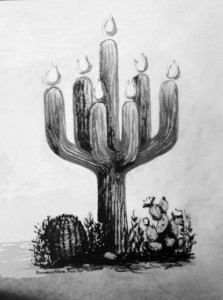Learning Discretion
Posted in General on September 20th, 2010 by Eugene Finerman – Be the first to commentSeptember 20. 1596: Monterrey, Mexico is Founded…again
 The first time the settlement had a zoning problem. The governor, his family and most of the original settlers were not in compliance with the “Catholics Only” requirement. There had been a slight change in Spanish colonial policy, but Luis de Carabajal and the other settlers evidently took too Talmudic an interpretation.
The first time the settlement had a zoning problem. The governor, his family and most of the original settlers were not in compliance with the “Catholics Only” requirement. There had been a slight change in Spanish colonial policy, but Luis de Carabajal and the other settlers evidently took too Talmudic an interpretation.
Some sixty years earlier, at the time of Cortes, Spanish colonial policy was rather ecumenical. As long as you were greedy and murderous, no one cared how pious a Catholic you were. If any monks were checking codpieces, it was probably a hobby rather than a theological examination. The Conquistadors went where the gold was–southern and central Mexico–and there they established Spanish rule: slaughter, enslavement and rape, followed by haciendas and Cathedrals. However, Northern Mexico did not offer such riches, so it was largely spared such Spanish benefits.
After the initial conquest, with all its sociopathic liberties, civilization began encroaching on the Spanish colony. In the mid-16th century, Spain had adopted racial laws that discriminated against anyone with Jewish ancestry. By the standards of the Limpieza de Sangre (the Purity of Blood), you were irretrievably tainted if you had even one Jewish great-grandparent. This policy was applied to Spain’s colonies in the New World, and the Inquisition was always eager to enforce it. No one was supposed to live in Mexico who was more than 1/16th Jewish.
Luis de Carabajal y Cueva certainly failed that test. He had been born Catholic but neither of his parents could have made that claim. Nonetheless, he had demonstrated skill as a soldier, explorer and slave trader; so the Spanish government was willing to overlook his incriminating ancestry. The Spanish Crown had now decided to establish settlements in Northern Mexico, and toward that end it was prepared to waive the restrictions of the Limpieza de Sangre. New Christians–as they were called–would be tolerated there, and Luis de Carabajal was named the founding governor.
Arriving in Mexico in 1580, with his family, relatives and friends, Carabajal moved north to found the settlement that became Monterrey. Nearly everyone there was a New Christian; and it was no secret. Who else would want to be in that wilderness, hundreds of miles from Mexico City? But some of the colonists overestimated either Spanish tolerance or their distance from the Inquisition. Many thought that they were free to resume being Jewish. In 1590, the Inquisition corrected them. The colony was depopulated, most of its residents arrested and brought to Mexico City for interrogation. The rack and the waterboard prompted a number of confessions. Luis de Carabajal died in custody. Most of his family and some hundred others were burned alive.
Six years later, a new colony was founded on the site of Carabajal’s settlement. Once again, the pioneers were New Christians but these people had no delusions about their safety. There were no further heresies, just a series of idiosyncrasies. For instance, chickens in Monterrey were killed in a way vaguely kosher. And many headstones in Monterrey featured a pair of hands as if in benediction. It is, but not a Catholic one. At least in death, one could make a last, defiant Jewish gesture.